-
 Bitcoin
Bitcoin $108,708.8110
0.60% -
 Ethereum
Ethereum $2,561.6057
1.91% -
 Tether USDt
Tether USDt $1.0001
-0.03% -
 XRP
XRP $2.2795
0.57% -
 BNB
BNB $662.2393
1.00% -
 Solana
Solana $153.1346
3.74% -
 USDC
USDC $1.0000
0.00% -
 TRON
TRON $0.2877
0.97% -
 Dogecoin
Dogecoin $0.1710
3.93% -
 Cardano
Cardano $0.5871
1.61% -
 Hyperliquid
Hyperliquid $39.6663
1.68% -
 Sui
Sui $2.9032
0.79% -
 Bitcoin Cash
Bitcoin Cash $496.1879
1.71% -
 Chainlink
Chainlink $13.5807
3.01% -
 UNUS SED LEO
UNUS SED LEO $9.0777
0.61% -
 Stellar
Stellar $0.2514
4.51% -
 Avalanche
Avalanche $18.1761
1.86% -
 Shiba Inu
Shiba Inu $0.0...01173
1.72% -
 Toncoin
Toncoin $2.8010
-4.23% -
 Hedera
Hedera $0.1594
3.21% -
 Litecoin
Litecoin $87.0257
-0.53% -
 Monero
Monero $319.1217
1.79% -
 Polkadot
Polkadot $3.3853
0.68% -
 Dai
Dai $0.9999
-0.01% -
 Ethena USDe
Ethena USDe $1.0003
0.02% -
 Bitget Token
Bitget Token $4.3420
-0.97% -
 Uniswap
Uniswap $7.3772
1.39% -
 Aave
Aave $286.6277
5.61% -
 Pepe
Pepe $0.0...09994
2.33% -
 Pi
Pi $0.4589
1.76%
How to monitor the abnormal activities of PEPE whale addresses?
Monitoring PEPE whale activities involves using blockchain tools like Etherscan and Nansen, setting up alerts, and analyzing transaction patterns to predict market movements.
Apr 25, 2025 at 02:01 am
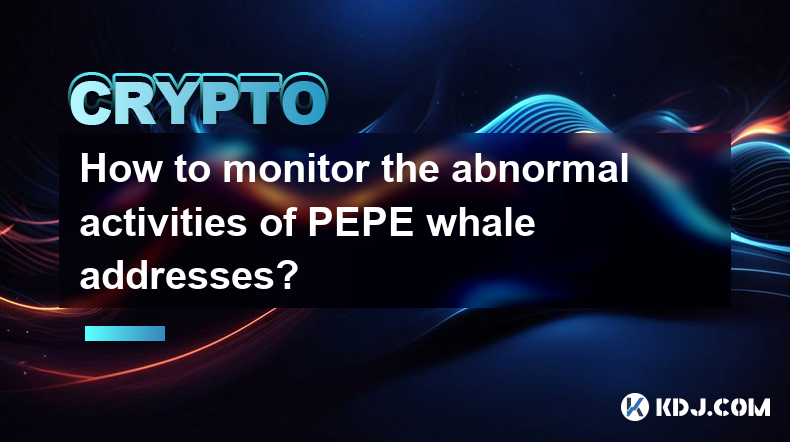
Monitoring the abnormal activities of PEPE whale addresses requires a systematic approach that combines the use of blockchain analytics tools, understanding of market behavior, and regular monitoring of transactions. This article will guide you through the essential steps and tools needed to effectively track and analyze the movements of large PEPE holders, commonly known as whales.
Understanding PEPE Whales and Their Impact
PEPE whales are individuals or entities that hold a significant amount of PEPE tokens. Their large holdings give them the power to influence the market, often leading to price fluctuations when they buy or sell in large volumes. Monitoring their activities can provide insights into potential market movements and help you make more informed trading decisions.
To begin, it's crucial to understand what constitutes abnormal activity. This can include sudden large transfers, significant changes in holding patterns, or unusual transaction frequencies. By identifying these patterns, you can better predict potential impacts on the PEPE market.
Tools for Monitoring PEPE Whale Addresses
Several blockchain analytics tools can help you track the activities of PEPE whale addresses. Some of the most popular tools include:
- Etherscan: A blockchain explorer that allows you to search for specific addresses and view their transaction history. You can use Etherscan to monitor the balance and transaction activities of known whale addresses.
- Nansen: A platform that provides in-depth analytics on blockchain data, including wallet movements and token flows. Nansen can help you identify whale addresses and track their activities over time.
- DeBank: A tool that offers insights into DeFi wallets and their transactions. DeBank can be useful for tracking whale activities within the DeFi ecosystem.
Each of these tools has its strengths and can be used in combination to provide a comprehensive view of PEPE whale activities.
Setting Up Alerts for Abnormal Activities
To effectively monitor abnormal activities, setting up alerts is crucial. Here's how you can do it:
- Using Etherscan Alerts: Navigate to the Etherscan website, search for the whale address you want to monitor, and click on the "Alerts" tab. You can set up custom alerts for specific events, such as when the address receives or sends a certain amount of PEPE tokens.
- Nansen's Real-Time Alerts: Log into your Nansen account, go to the "Alerts" section, and set up custom alerts based on wallet movements, token transfers, or other criteria relevant to PEPE whales.
- DeBank Notifications: In DeBank, you can set up notifications for specific wallets or transactions. This can help you stay updated on any unusual activities from PEPE whale addresses.
By setting up these alerts, you can receive real-time notifications of any significant changes in the activities of PEPE whales.
Analyzing Transaction Patterns
Once you have the tools and alerts in place, the next step is to analyze the transaction patterns of PEPE whale addresses. This involves:
- Tracking Large Transfers: Look for any large transfers of PEPE tokens to or from whale addresses. These can indicate potential market movements or strategic positioning by the whales.
- Monitoring Holding Changes: Keep an eye on the overall holdings of whale addresses. Sudden increases or decreases in their PEPE holdings can signal upcoming market shifts.
- Identifying Unusual Transaction Frequencies: Pay attention to the frequency of transactions from whale addresses. An increase in transaction frequency could indicate active trading or preparation for a significant move.
By analyzing these patterns, you can gain a deeper understanding of the intentions and strategies of PEPE whales.
Using On-Chain Data to Enhance Monitoring
On-chain data provides valuable insights into the activities of PEPE whale addresses. Here are some key metrics to consider:
- Volume of Transactions: High transaction volumes from whale addresses can indicate increased market activity or potential price movements.
- Token Flows: Tracking the flow of PEPE tokens between different addresses can help you understand the distribution and concentration of holdings.
- Network Activity: Analyzing overall network activity can provide context for the activities of individual whale addresses.
By integrating on-chain data into your monitoring strategy, you can enhance your ability to detect abnormal activities and make more informed decisions.
Case Studies of Abnormal PEPE Whale Activities
To illustrate how to monitor abnormal activities, let's look at a few case studies:
- Case Study 1: Sudden Large Transfer: A PEPE whale address suddenly transfers a significant amount of tokens to a new address. By monitoring this activity through Etherscan and setting up alerts, you can track the subsequent movements of these tokens and assess their potential impact on the market.
- Case Study 2: Holding Pattern Change: A whale address that typically holds a stable amount of PEPE tokens suddenly increases its holdings by a large margin. Using Nansen, you can analyze this change and determine if it signals a bullish trend or a strategic accumulation.
- Case Study 3: Unusual Transaction Frequency: A whale address starts making frequent transactions, which is unusual for its historical behavior. By using DeBank to monitor these transactions, you can identify any patterns or anomalies that could indicate upcoming market movements.
These case studies demonstrate the importance of using a combination of tools and data to effectively monitor and analyze the activities of PEPE whales.
Frequently Asked Questions
Q: Can monitoring PEPE whale activities guarantee profitable trades?
A: No, monitoring PEPE whale activities can provide valuable insights, but it does not guarantee profitable trades. Market conditions, other influencing factors, and individual trading strategies all play a role in determining trading outcomes.
Q: How often should I check for updates on PEPE whale activities?
A: It's recommended to check for updates at least daily, especially if you have set up real-time alerts. However, the frequency can be adjusted based on market volatility and your trading strategy.
Q: Are there any risks associated with relying on whale activity data?
A: Yes, there are risks. Whale activities can be misleading, and whales may engage in strategies to manipulate the market. It's important to use whale activity data as one of many tools in your trading arsenal and not rely solely on it.
Q: Can I use the same methods to monitor whale activities on other cryptocurrencies?
A: Yes, the methods described in this article can be adapted to monitor whale activities on other cryptocurrencies. However, you may need to use different tools or platforms depending on the specific blockchain and token you are tracking.
Disclaimer:info@kdj.com
The information provided is not trading advice. kdj.com does not assume any responsibility for any investments made based on the information provided in this article. Cryptocurrencies are highly volatile and it is highly recommended that you invest with caution after thorough research!
If you believe that the content used on this website infringes your copyright, please contact us immediately (info@kdj.com) and we will delete it promptly.
- Ethereum Price Eyes $2610 Breakout Amidst Institutional Inflows and 'Giga Era' Buzz
- 2025-07-07 20:30:12
- Tariff Deadline, Crypto Bull Run, and Trade Tensions: A Perfect Storm?
- 2025-07-07 20:30:12
- Bitcoin Wallet Hack? Coinbase Exec Sounds the Alarm on $8B Whale Movement
- 2025-07-07 18:30:12
- Mercado Bitcoin, Tokenization, and XRP Ledger: A Latin American Power Play
- 2025-07-07 18:30:12
- XYZVerse, Wall Street, and the Crypto Upswing: What's the Deal?
- 2025-07-07 19:10:12
- AI, Web3, and Communities: Building the Future Together
- 2025-07-07 19:10:12
Related knowledge
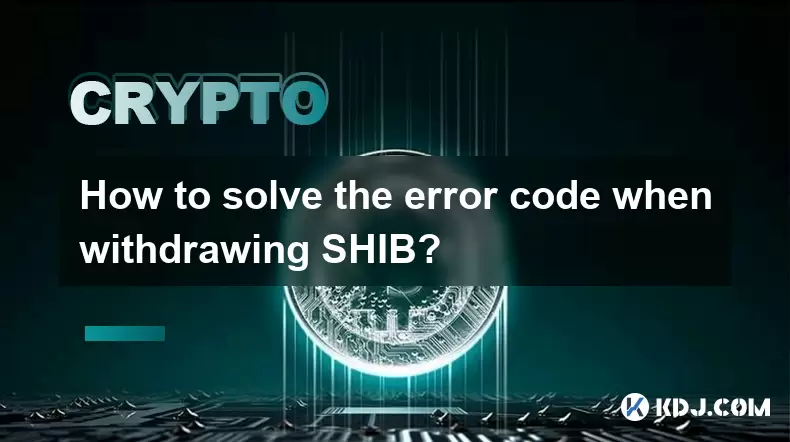
How to solve the error code when withdrawing SHIB?
May 14,2025 at 02:22am
Understanding Error Codes When Withdrawing SHIBWhen you attempt to withdraw Shiba Inu (SHIB) from an exchange or wallet, you might encounter various error codes. Understanding these error codes is crucial to successfully completing your transactions. Error codes are typically generated to inform users of specific issues that need to be addressed before ...

Can the SHIB withdrawal address be reused? Is it safe?
May 13,2025 at 04:42pm
Introduction to SHIB Withdrawal AddressesWhen it comes to Shiba Inu (SHIB) transactions, one of the critical aspects users need to understand is the nature and safety of withdrawal addresses. The SHIB withdrawal address plays a pivotal role in ensuring that your tokens are transferred securely from one wallet to another. A common question among users is...

What is the minimum withdrawal amount for SHIB? Is there a threshold?
May 13,2025 at 03:29pm
When it comes to withdrawing SHIB (Shiba Inu) from various cryptocurrency platforms, understanding the minimum withdrawal amount and any associated thresholds is crucial for managing your transactions efficiently. This article will delve into the specifics of SHIB withdrawals, focusing on the minimum amounts required, how these thresholds are set, and w...
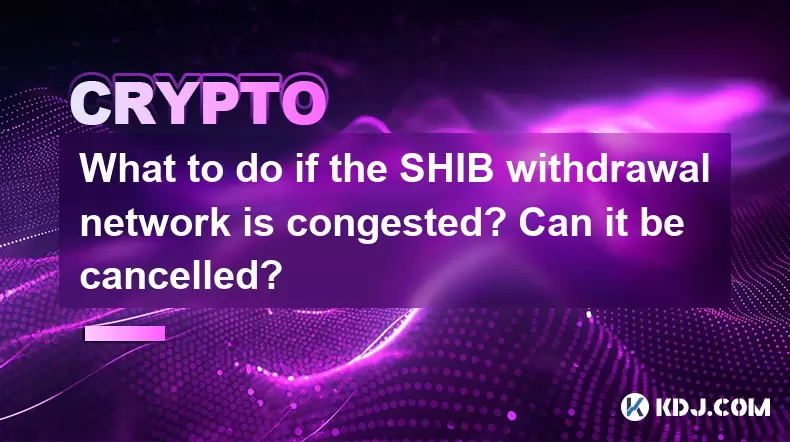
What to do if the SHIB withdrawal network is congested? Can it be cancelled?
May 13,2025 at 05:07pm
If you're facing issues with the SHIB withdrawal network being congested, it's important to understand your options and the steps you can take. Congestion in the network can lead to delays in transaction processing, and knowing whether you can cancel a pending transaction is crucial. Let's explore this topic in detail. Understanding SHIB Withdrawal Netw...
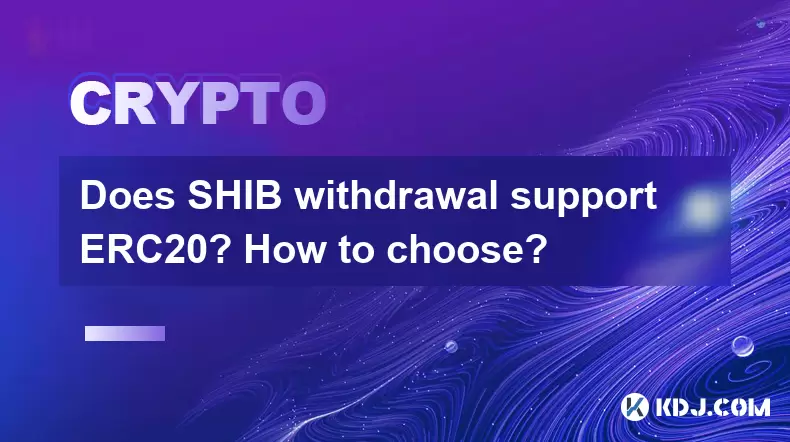
Does SHIB withdrawal support ERC20? How to choose?
May 14,2025 at 02:56am
Does SHIB withdrawal support ERC20? How to choose? Shiba Inu (SHIB) is a popular cryptocurrency that often raises questions about its withdrawal options, particularly in relation to the ERC20 token standard. This article will explore whether SHIB withdrawal supports ERC20 and provide a detailed guide on how to choose the best withdrawal method for your ...
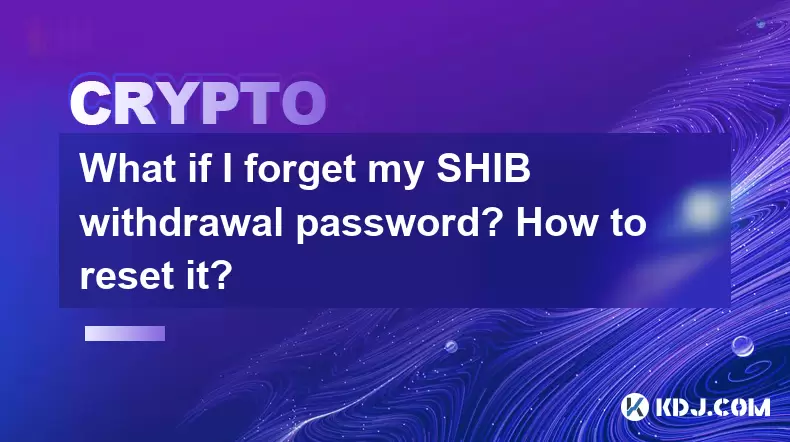
What if I forget my SHIB withdrawal password? How to reset it?
May 13,2025 at 03:15pm
Forgetting your SHIB withdrawal password can be a stressful experience, especially if you are eager to access your funds. Fortunately, there are steps you can take to reset your password and regain access to your SHIB. This article will guide you through the process of resetting your SHIB withdrawal password, ensuring that you can continue to manage you...

How to solve the error code when withdrawing SHIB?
May 14,2025 at 02:22am
Understanding Error Codes When Withdrawing SHIBWhen you attempt to withdraw Shiba Inu (SHIB) from an exchange or wallet, you might encounter various error codes. Understanding these error codes is crucial to successfully completing your transactions. Error codes are typically generated to inform users of specific issues that need to be addressed before ...

Can the SHIB withdrawal address be reused? Is it safe?
May 13,2025 at 04:42pm
Introduction to SHIB Withdrawal AddressesWhen it comes to Shiba Inu (SHIB) transactions, one of the critical aspects users need to understand is the nature and safety of withdrawal addresses. The SHIB withdrawal address plays a pivotal role in ensuring that your tokens are transferred securely from one wallet to another. A common question among users is...

What is the minimum withdrawal amount for SHIB? Is there a threshold?
May 13,2025 at 03:29pm
When it comes to withdrawing SHIB (Shiba Inu) from various cryptocurrency platforms, understanding the minimum withdrawal amount and any associated thresholds is crucial for managing your transactions efficiently. This article will delve into the specifics of SHIB withdrawals, focusing on the minimum amounts required, how these thresholds are set, and w...

What to do if the SHIB withdrawal network is congested? Can it be cancelled?
May 13,2025 at 05:07pm
If you're facing issues with the SHIB withdrawal network being congested, it's important to understand your options and the steps you can take. Congestion in the network can lead to delays in transaction processing, and knowing whether you can cancel a pending transaction is crucial. Let's explore this topic in detail. Understanding SHIB Withdrawal Netw...

Does SHIB withdrawal support ERC20? How to choose?
May 14,2025 at 02:56am
Does SHIB withdrawal support ERC20? How to choose? Shiba Inu (SHIB) is a popular cryptocurrency that often raises questions about its withdrawal options, particularly in relation to the ERC20 token standard. This article will explore whether SHIB withdrawal supports ERC20 and provide a detailed guide on how to choose the best withdrawal method for your ...

What if I forget my SHIB withdrawal password? How to reset it?
May 13,2025 at 03:15pm
Forgetting your SHIB withdrawal password can be a stressful experience, especially if you are eager to access your funds. Fortunately, there are steps you can take to reset your password and regain access to your SHIB. This article will guide you through the process of resetting your SHIB withdrawal password, ensuring that you can continue to manage you...
See all articles

























































































